6th Century Dharmapuri Temple Jagtial
The Dharmapuri Temple also known as Dharmapuri Lakshmi Narasimha Swamy Temple is a Hindu temple dedicated to the god Vishnu in the form of Narasimha, located in the town of Dharmapuri in the Jagtial district of Telangana, India. It is one of the nine Narasimha Kshetras of Telangana and Andhra Pradesh.
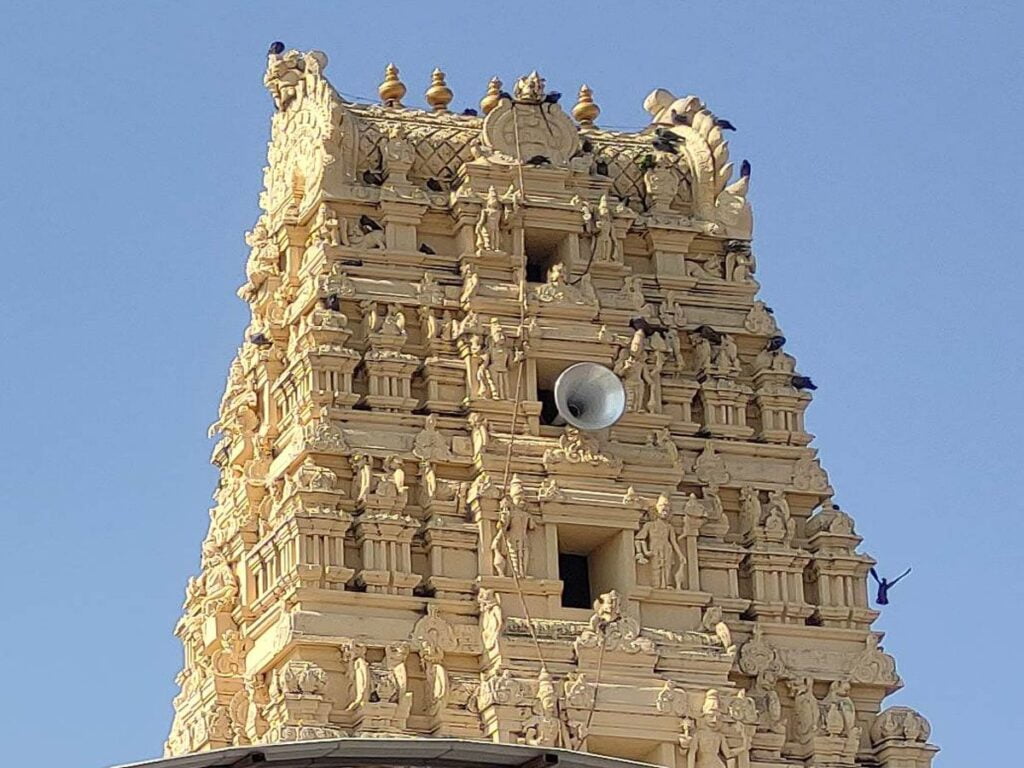
Contents
- 1 History of Dharmapuri Temple:
- 2 Legend of Dharmapuri Temple:
- 3 Myths and Beliefs of Dharmapuri Temple:
- 4 Significance of Dharmapuri Temple:
- 5 Dharmapuri Temple Timing and Rituals:
- 6 Places to visit near Dharmapuri Sri Lakshmi Narasimha Swamy Temple:
- 7 FAQ:
- 7.0.1 What is Dharmapuri Temple dedicated to?
- 7.0.2 When was Dharmapuri Temple built?
- 7.0.3 What are the main features of Dharmapuri Temple?
- 7.0.4 What are the important festivals celebrated at Dharmapuri Temple?
- 7.0.5 What are the timings of Dharmapuri Temple?
- 7.0.6 What are the entry fees for Dharmapuri Temple?
- 7.0.7 What are the dos and don’ts at Dharmapuri Temple?
- 7.0.8 What are some interesting facts about the Dharmapuri Temple?
- 7.0.9 What are the other nearby attractions?
- 8 How to reach Dharmapuri Temple:
- 9 Google Maps:
History of Dharmapuri Temple:
Early Origins and Chalukya Legacy:
- While the exact origins remain shrouded in some mystery, historical evidence suggests the temple’s construction dates back to the Chalukya dynasty, which ruled the Deccan region between the 6th and 12th centuries.
- Inscriptions found within the temple complex point to the reign of Chalukya king Vijayaditya VII (847-888 AD) as a possible period of construction or expansion.
- Architectural elements and sculptures showcasing the distinctive Chalukya style further support this attribution.
Kakatiya Influence and Continued Importance:
- The temple’s history extends beyond its Chalukya origins. The subsequent Kakatiya dynasty, renowned for its architectural prowess, is believed to have contributed to the temple’s embellishments and expansions.
- The intricate carvings and sculptures adorning the temple walls and pillars bear testament to the Kakatiya artistry, blending seamlessly with the earlier Chalukya style.
- Throughout the centuries, the Dharmapuri Temple remained a prominent pilgrimage site and center of Vaishnava worship, attracting devotees from across the region.
Read More>> Ekambeswarar Temple, Kumbakonam
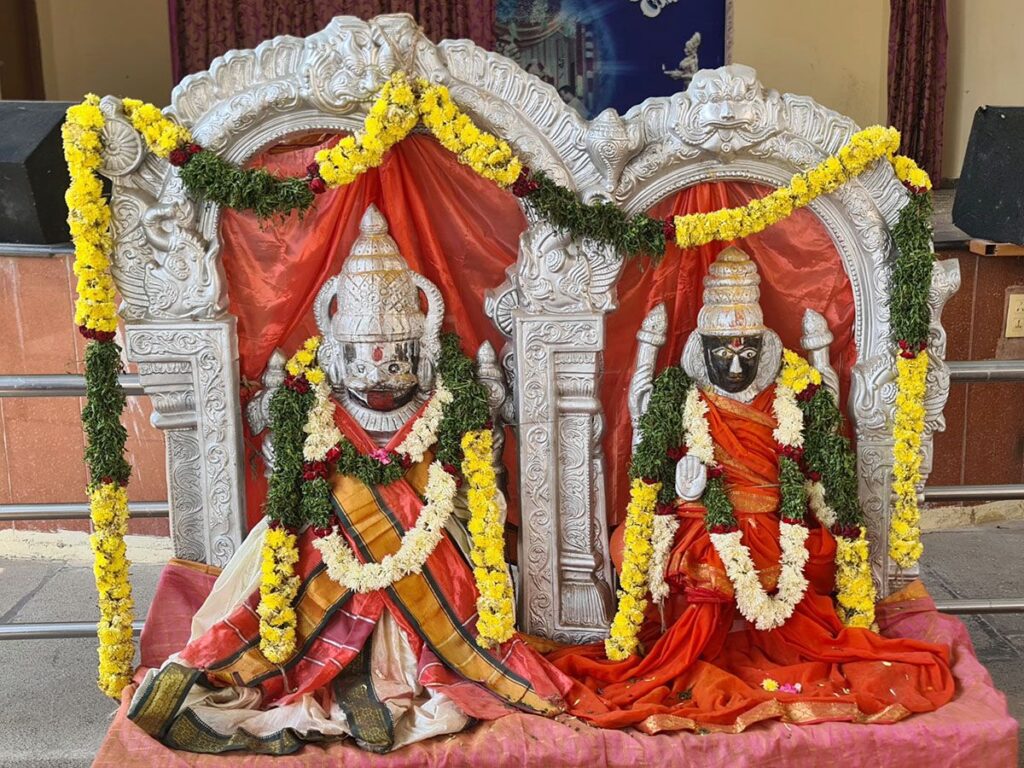
Legend of Dharmapuri Temple:
One of the most popular legends about the Dharmapuri temple is the story of how it was built. According to the legend, a sage named Dharmapuri Rishi was meditating in the forest when he was visited by Lord Vishnu. Lord Vishnu told the sage that he wanted to build a temple in his honor and asked the sage to help him.
The sage agreed to help Lord Vishnu and the two of them began to build the temple. They worked day and night and the temple was soon completed. Lord Vishnu was pleased with the temple and he blessed the sage. The sage then became known as Dharmapuri Rishi and the temple became known as Dharmapuri Temple.
Another legend about the Dharmapuri temple is the story of how it saved the town of Jagityal from a flood. According to the legend, a flood was about to destroy the town of Jagityal. The townspeople prayed to Lord Vishnu for help and Lord Vishnu appeared to them in a dream.
Lord Vishnu told the townspeople that he would save them if they would build a temple in his honor. The townspeople agreed to build the temple and as soon as they started construction, the floodwaters receded. The town of Jagityal was saved and the Dharmapuri temple became even more revered.
Read More>> Yadagirigutta Temple: Where Narasimha Comes Alive in 5 Forms
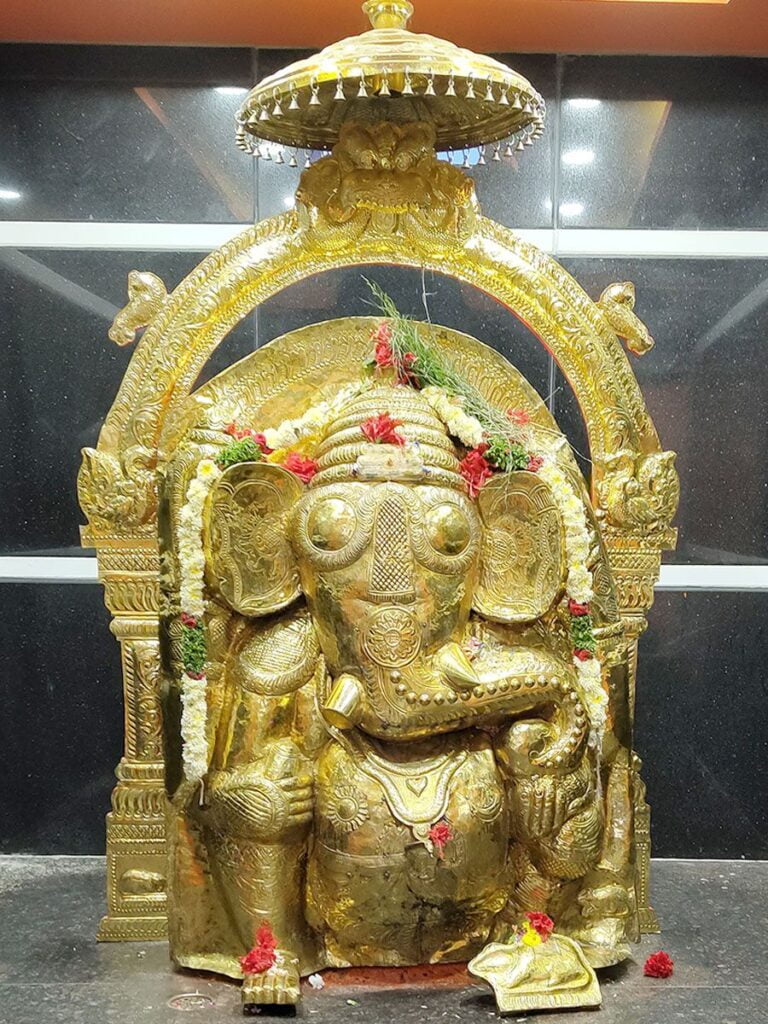
Myths and Beliefs of Dharmapuri Temple:
Myth of the Swayambhulinga:
The most prominent myth associated with the Dharmapuri Temple is the story of the Swayambhulinga, or self-manifested Shiva linga. According to legend, a cowherd named Dharma was grazing his cattle near the present-day temple site when he saw a linga emerging from the ground. He recognized it as a divine manifestation of Lord Shiva and started worshipping it. The news of the Swayambhulinga spread, and soon the place became a pilgrimage center.
Beliefs about the temple:
- The wish-fulfilling powers of the Swayambhulinga: Devotees believe that praying to the Swayambhulinga with a sincere heart can fulfill their wishes. Many stories are told about people who have experienced miracles after praying at the temple.
- The healing powers of the Nandi bull: The temple also houses a large statue of Nandi, the bull that is Lord Shiva’s vehicle. Devotees believe that touching the Nandi statue can cure diseases and bring good health.
- The importance of the Shivratri festival: The Shivratri festival is celebrated with great fervor at the Dharmapuri Temple. Devotees believe that offering prayers to Lord Shiva on this day can bring immense blessings.
Other myths and beliefs:
- There is a belief that the five ponds surrounding the temple represent the five elements of nature – earth, water, fire, air, and space.
- The peepal tree near the temple is considered sacred and is believed to be the abode of spirits.
- Devotees also believe that the temple is located on a powerful energy vortex, which can help in meditation and spiritual growth.
Read More>> Ananthagiri Temple Vikarabad: Where Myths and Legends Come to Life
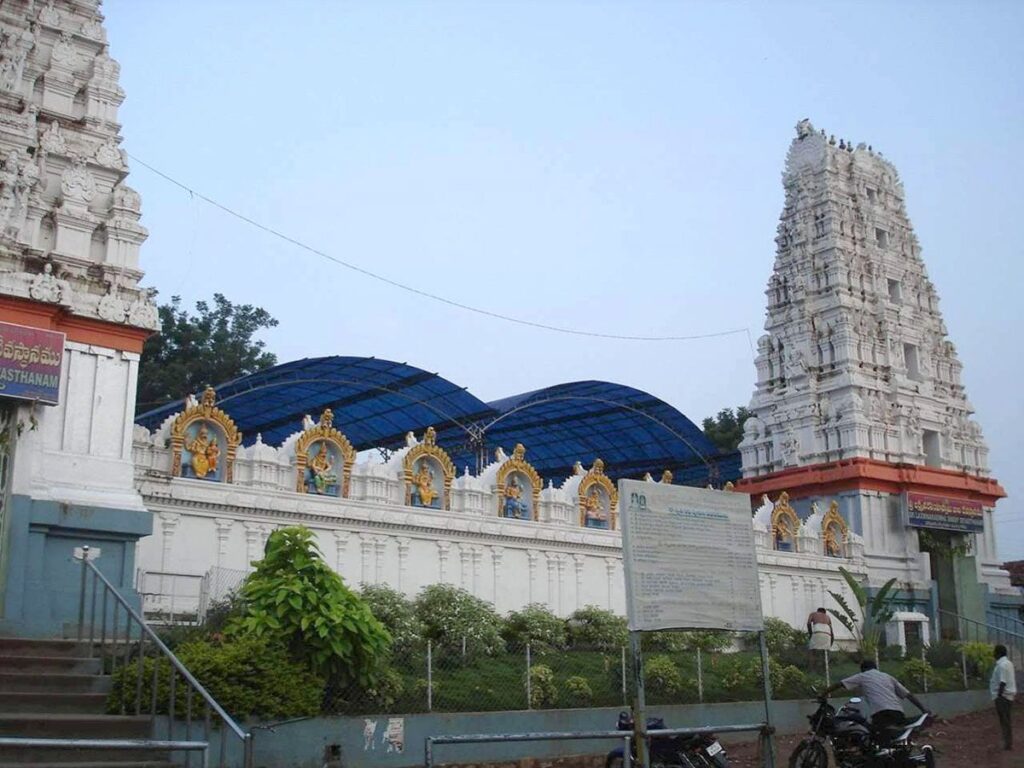
Significance of Dharmapuri Temple:
Religious Importance:
- Dedicated to Lord Lakshmi Narasimha Swamy: The temple enshrines a majestic idol of Lord Lakshmi Narasimha Swamy, an incarnation of Lord Vishnu. This makes it one of the nine prominent Narasimha Kshetrams (holy abodes) in Telangana and Andhra Pradesh.
- Other Deities: Besides the main deity, the temple complex houses shrines dedicated to other Hindu gods and goddesses like Shiva, Venkateshwara, Gouthameshwara, Anjaneya, Sri Rama, Datthathreya, and Sathyavathi. A holy pond known as Brahma Pushkarini further adds to the temple’s sanctity.
Historical Significance:
- Ancient Origins: Though the exact date of construction remains unclear, the temple is believed to be centuries old. Some historical accounts suggest its existence even before the 17th century.
- Vedic and Cultural Center: Dharmapuri has been a renowned center for Vedic learning, Shastras, Puranas, fine arts, and poetry for centuries. Renowned poets and scholars like Cherikonda Dharmana, Krishnagiri Venkatagiri, and Sheshappa hailed from this village.
Social and Cultural Significance:
- Pilgrimage Center: The temple attracts a large number of devotees throughout the year, especially during festivals like Brahmotsav, which is held annually after Holi.
- Weddings and Blessings: Many couples choose to get married at the Dharmapuri Temple, seeking the blessings of Lord Lakshmi Narasimha Swamy for a happy and prosperous life together.
Read More>> 2500 Years Dwarkadhish Temple: Where Miracles Still Happen
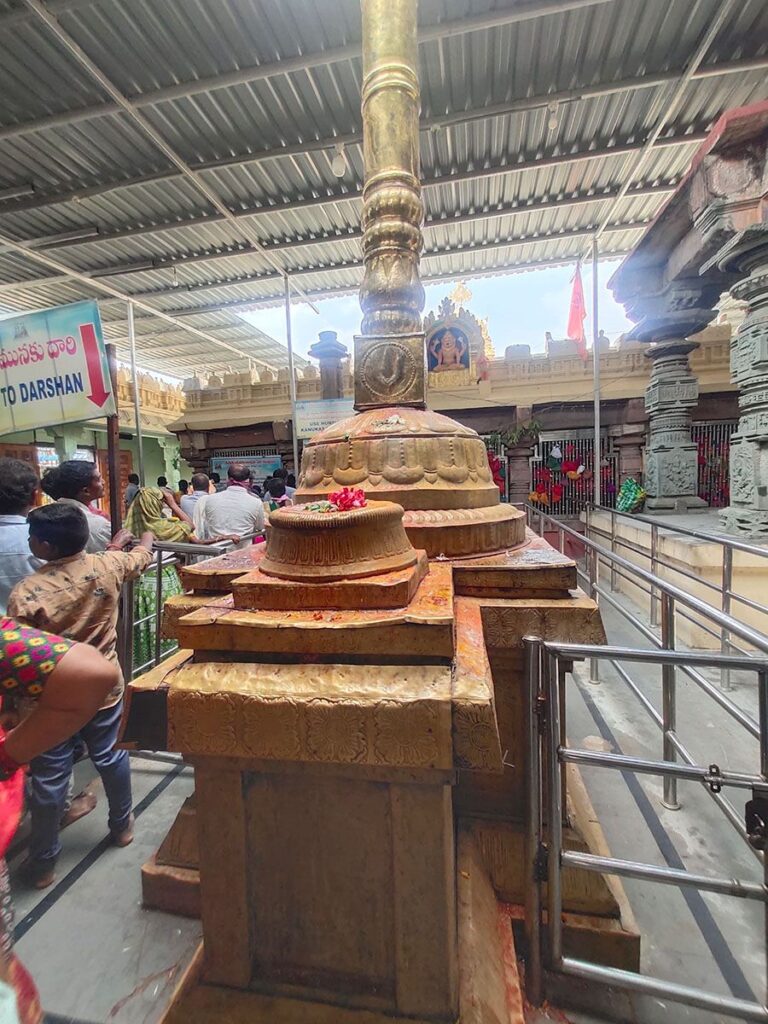
Dharmapuri Temple Timing and Rituals:
Timings:
The temple is open from 6:00 AM to 8:00 PM. The main pooja is performed at 9:00 AM and 6:00 PM.
Rituals:
The main rituals performed at the temple are the abhishekam, alankara, and naivedyam. The abhishekam is a ritual bath performed on the idol of the deity. The alankara is a ritual of decorating the idol with flowers and ornaments. The naivedyam is a food offering made to the deity.
Here are some of the specific rituals performed at the Dharmapuri Temple:
- Abhishekam: The abhishekam is performed on the idol of the deity with milk, panchamrita, and other sacred substances. This ritual is believed to cleanse the idol and remove any negative energies.
- Alankara: The alankara is performed on the idol of the deity with flowers, fruits, and ornaments. This ritual is believed to beautify the idol and make it more pleasing to the devotees.
- Naivedyam: The naivedyam is a food offering made to the deity. The food is usually cooked rice, fruits, and sweets. This ritual is believed to nourish the deity and express the gratitude of the devotees.
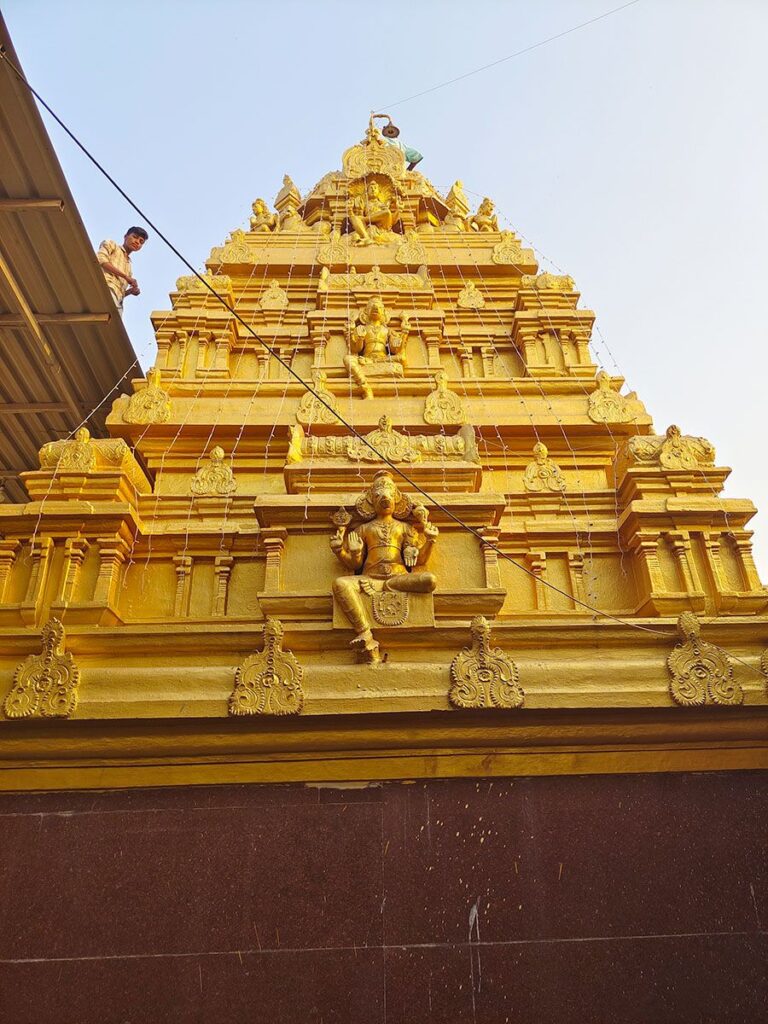
Places to visit near Dharmapuri Sri Lakshmi Narasimha Swamy Temple:
- Hogenakkal Falls: Known as the “Niagara of India,” Hogenakkal Falls is around 46 kilometers from Dharmapuri. The waterfall on the Kaveri River is famous for its medicinal baths and boat rides.
- Krishnagiri Dam: Approximately 47 kilometers from Dharmapuri, Krishnagiri Dam is a popular spot for picnics. The dam offers a beautiful view of the surrounding hills and a serene environment.
- Theerthamalai Temple: Situated around 20 kilometers from Dharmapuri, Theerthamalai Temple is known for its natural spring and is surrounded by hills, making it a peaceful and scenic location.
- Subramanya Siva Memorial: Located in Dharmapuri, this memorial is dedicated to the Tamil poet and philosopher Subramanya Siva. It’s a place of historical and cultural significance.
- Chenraya Perumal Temple: This temple is situated in Hosur, around 60 kilometers from Dharmapuri. It is known for its architectural beauty and historical importance.
- Adiyamankottai: Adiyamankottai is a historic fort located about 10 kilometers from Dharmapuri. The fort provides a glimpse into the region’s past and offers panoramic views of the surrounding areas.
FAQ:
What is Dharmapuri Temple dedicated to?
Dharmapuri Temple is dedicated to Lord Vishnu, the Hindu god of preservation. The temple is also known as the “Dharmapuri Varaha Swamy Temple” because the main deity is a form of Vishnu known as Varaha, the boar incarnation.
When was Dharmapuri Temple built?
The exact date of construction of Dharmapuri Temple is unknown, but it is believed to be over 1,000 years old. The temple is a protected monument under the Archaeological Survey of India.
What are the main features of Dharmapuri Temple?
The temple is built in the Dravidian style of architecture. The main shrine is a square structure with a pyramidal tower. The tower is decorated with intricate carvings of Hindu deities and symbols. The temple complex also includes a number of other shrines dedicated to other Hindu deities.
What are the important festivals celebrated at Dharmapuri Temple?
The most important festival celebrated at Dharmapuri Temple is the Vaikunta Ekadasi festival. This festival is celebrated every year in the month of December. On this day, devotees from all over the state come to the temple to offer prayers.
What are the timings of Dharmapuri Temple?
The temple is open from 6:00 AM to 8:00 PM. The main pooja is performed at 9:00 AM and 6:00 PM.
What are the entry fees for Dharmapuri Temple?
There is no entry fee for Dharmapuri Temple.
What are the dos and don’ts at Dharmapuri Temple?
It is important to dress modestly when visiting Dharmapuri Temple. It is also important to remove your shoes before entering the temple.
What are some interesting facts about the Dharmapuri Temple?
The temple is said to be built by the Kakatiya dynasty in the 12th century. The temple is known for its intricate carvings and sculptures, which depict scenes from Hindu mythology. The temple is also home to a large tank, called the Dharmapuri Pushkarini, which is believed to have miraculous powers.
What are the other nearby attractions?
There are several other nearby attractions, including:
Siddipet Fort: The Siddipet Fort is a 16th-century fort that was built by the Qutb Shahi dynasty.
Siddipet Museum: The Siddipet Museum houses a collection of artifacts from the region’s history.
Siddipet Wildlife Sanctuary: The Siddipet Wildlife Sanctuary is home to a variety of animals, including tigers, leopards, and elephants.
How to reach Dharmapuri Temple:
By Air: The nearest airport to Dharmapuri is Kempegowda International Airport (BLR) in Bangalore. From the airport, you can hire a taxi or take a bus to reach Dharmapuri.
By Train: The nearest railway station is Dharmapuri Railway Station. The temple is around 2 km from the railway station. You can hire a taxi or an auto-rickshaw to reach the temple.
By Road: Dharmapuri is well-connected by roads. You can reach Dharmapuri by bus or private vehicle. The temple is located in the heart of Dharmapuri town, and you can easily find local transportation options like auto-rickshaws or cycle rickshaws to reach the temple.
Here are the general steps to reach Dharmapuri Sri Lakshmi Narasimha Swamy Temple:
- Reach Dharmapuri:
- If you are traveling by air, land at Kempegowda International Airport in Bangalore and then proceed to Dharmapuri.
- If you are traveling by train, reach Dharmapuri Railway Station.
- Local Transportation:
- From the airport or railway station, hire a taxi or take a bus to reach Dharmapuri town.
- Navigate to the Temple:
- Once in Dharmapuri town, you can use local transportation like auto-rickshaws or cycle rickshaws to reach the Sri Lakshmi Narasimha Swamy Temple.
- Ask Locals:
- If you are unsure about the directions, feel free to ask locals for guidance. They will likely be happy to help you find the temple.
- Use Navigation Apps:
- You can also use navigation apps on your smartphone to get turn-by-turn directions to the temple.
